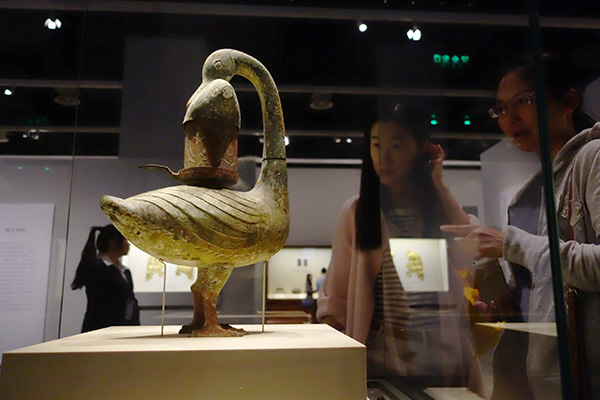
An ancient gang deng lamp, which features a wild goose with a turned head holding a fish in its mouth, is among exhibits at an ongoing National Museum of China exhibition.[Photo/China Daily]
National Museum of China is currently holding an exhibition that showcases items made by Chinese artisans centuries ago.
At a time when people relied heavily on oil lamps, the smoke they emitted would pervade the rooms they lit. To solve this problem, Chinese artisans more than 2,000 years ago developed the gang deng, a beautifully crafted lamp with a smoke-guiding tube.
A fine example of such a lamp is a painted bronze piece that dates back to the Western Han Dynasty (206 BC-AD 24).
Its main body was crafted as a wild goose with a turned head holding a fish in its mouth.
The fish has two movable, arched plates to prevent the smoke from coming out. Under the plates is the lamp panel that is attached to the goose’s belly.
When users lit the lamp, the smoke would run through the fish, then the goose’s long neck-the guiding tube-and finally into its belly which was filled with water to dissolve the smoke.
There are also other gang deng lamps, made like human figures and animals, whose limbs, necks or horns function as the smoke-guiding tube. The delicate and colorful patterns on these lamps give great aesthetic value to them.
The Western Han goose lamp is part of the collection at the National Museum of China since 2010. People can now get a close took at it at an exhibition showing a selection of 120 antiques that were added to the museum’s collection over the past few years.
Bronze ware, paintings, Buddhist figurines and other antiques are also displayed at the museum exhibition.
NMC typically depends on government funds and private donations to boost its collection. And through these two avenues it has collected about 400,000 antique pieces over the past two decades.
From 2003-11, the NMC was granted an annual allocation of 50 million yuan ($7.6 million) to buy antiques.
But this was raised to 100 million yuan in 2012 as prices of antiques rose.
In addition, the museum can also apply for money from special funds set up by the central government to purchase antiques of great significance.
Such fiscal support has enabled the NMC to collect dozens of antiques that are seen as national treasures. They include a wooden painted figure of a seated Buddha that was purchased from a Chinese-American collector 10 years ago. The figure, which is 2 meters tall, is a fine example of Buddhist art during the Song Dynasty (960-1279).
Despite the generous financial support, Shan Yueying, a curator at the NMC, says the rising prices of antiques means that acquiring many museum-quality pieces is often impossible.
Despite this, she says, the museum has been successful in collecting a lot of bronze ware as the market for this category of antiques is undervalued.
However, NMC does not have deep enough pockets to acquire pieces from the highly competitive market of Chinese paintings.
Xie Xiaoquan, who is in charge of the museum’s department that collects antiques, says that although auction catalogs are a major channel for them to learn about antiques that are available for sale and their prices, NMC has never bought antiques at auctions.
He says this is because there are often too many unexpected situations in sales rooms, which are difficult to handle, for instance, when the bidding price rises beyond what NMC can offer.
Typically, NMC contacts people who plan to sell collectibles either through auction, privately or in other ways.
Shan says: “The price we can afford may be lower than what can be achieved in the market, but we do not spare any effort in persuading the sellers.
“We do not collect for ourselves. It’s for our nation and the public good.”
Shan says that the ongoing exhibition hopes to raise public awareness about the importance and difficulties faced by public museums in collecting antiques, and by doing so hopes to draw donations to NMC, both from home and abroad.
A bulk of the antiques in the museum’s collection of recent decades are from donations by overseas antique collectors and some that were illegally transported abroad and later recovered by the government.
Among NMC’s list of more than 5,000 donors are internationally renowned antique collectors and connoisseurs like China’s Wang Shixiang, Goro Sakamoto of Japan and Robert H. Ellsworth from the United States.
On show at the exhibition are a pair of painted stone sculptures of warriors. They were unlawfully taken out from a tomb of the Five Dynasties and Ten Kingdoms period (AD 907-960) in 1994 and shipped overseas.
One was returned to China in 2001 after being withdrawn from a New York auction. Ellsworth donated the other to NMC after discovering that the piece was stolen and part of a pair.
Xie says: “Our collecting department is open to the public, and a lot of collectors know where and how to donate.
“We welcome private donations as long as they come with a correct provenance and are acquired through legitimate channels.”
If you go
9 am-5 pm, closed on Mondays, through March 10. National Museum of China, east of Tian’anmen Square, Beijing. 010-6511-6400.
